In this week’s episode, we learn all about the largest land-dwelling species of the family Mustelidae, the wolverine, and why they’re so special.
Part 1: During her first research project in the Sierra Nevada mountains, Katie Moriarty thinks she might have spotted the impossible: a wolverine.
Part 2: Science Journalist Katherine J. Wu interviews wildlife ecologist Katie Moriarty to find out more about these mystical wolverines.
Dr. Katie Moriarty is a forest wildlife ecologist. Throughout her career, Katie has studied elusive, forest dependent species such as pollinators, mammals, and birds. She is considered a leading expert on the Pacific marten, a small mammal in the weasel family. She currently works as a senior research scientist with the National Council for Air and Stream Improvement, Inc. (NCASI) where her research focuses on balancing the needs of sensitive wildlife species and biodiversity, with the goal of conservation within managed forest landscapes. Moriarty received Associate degrees from Sierra Community College, a bachelors from Humboldt State University, and her master’s and PhD from Oregon State University. Dr. Moriarty is active within The Wildlife Society, International Martes Working Group, and the IUCN Small Carnivore Group, working towards small carnivore conservation. Katie currently resides in Corvallis, Oregon with her family.
Story Transcript
I'm a research wildlife biologist and I have the great privilege of working with rare and elusive species. But this can also be an emotional crisis because, by definition, rare species are extremely difficult to find. So it's really hard to know if your job is to look for them in a very specific way and you do not find them when you expect. Are you entirely incompetent or are you, sadly, too late?
My best story about this is during my first research project. I'm high in the Sierra Nevada in this great mountain research station and it feels like Stonehenge. This place has the deepest history of marten biology scholars.
And if martens weren't already your favorite mammal in the weasel family, I think I should convince you, because otters and ferrets and honey badgers, they're just okay. Martens are equally playful, curious and so vicious they are terrifying. They're about the size of a 10‑week‑old kitten. Also, very adorable. You should look it up.
So, like my predecessors, I'm in this cabin in a mountain meadow and I have a bed and a desk and a shelf, and I have every single piece of literature, every map, every note highlighted, cross‑referenced. I know where every marten has been in 28 years.
Now, I'm going to write my own chapter and I have been preparing for months. I have all of these boxes out in the field and every day I walk three to six miles through the woods and I collect binders and binders of footprints looking for martens. And I collect binders and binders of rodent prints, squirrels, voles, sometimes a spotted skunk.
After two months, I'm wondering if it's me. So I start working seven days a week. I expand my grid 15 miles. I go anywhere anyone's ever heard of a marten and I find nothing. I have to go back to school but I vow I'm going to come back in winter and I vow I'm going to find a marten.
Time goes on. I come back in winter and it's completely different. There's a gate at the highway and it's a two‑mile snowmobiler ski into the station. Everything's winterized. It's all closed down. Now, I'm living in this garage turned into an apartment. I have a bed, a desk. I have a heater, which is new, and I have a bathroom, which is fairly nice, except for every time the ground freezes, sewage comes up through my shower.
Katie Moriarty shares her story at at Jewelbox Theater at the Rendezvous in Seattle in November 2022. Photo by Elizar Mercado.
But despite my accommodations, I am fully invested. I have borrowed remote cameras that take a picture if motion or heat passes by, so any animal that passes by. I have borrowed snowmobiles so I can get to these places. I have skis and I have borrowed winter clothes so I could survive.
I go out similarly every day and it is so much harder. Some days in Truckee, in this winter, it snows 18 inches in an hour. To get to these stations, I need to really, really push my physical limits. And every night, I strip off my snow gear and I look through these photos.
After a month of looking through photos, I start talking to the walls and I'm telling them exactly what I see. Snow, snow, snow. Douglas squirrel. Ooh, a spotted skunk.
One March morning, I'm going through these photos and I'm talking to myself, just as I always have been, and I see a photo that makes me paralyzed. I'm looking at an image. My heart speeds up. My breath almost stops and I just am so confused. I'm looking at an image. It's the only one picture. It's of a butt. It is the worst picture you could possibly take of an animal. No head, no body, just a butt.
But it looks like a bear that someone spray‑painted white stripes down the side. The only thing that I think it could be, which it's impossible to be, is a wolverine. A wolverine hasn't been seen in California in over 85 years.
I do what any wildlife biologist would do. I jump on the bed and scream profanities. I run back to the computer. It's still there. I run back to the bed. I jump for a while. And then, with all the grace I have, I put on all my snow gear, which is not graceful at all, and then I run out the door down these snow‑created stairs through a pavilion to this outdoor phone. It's the only way to get out of the research station. There's no cell service so I dial my calling card number my PIN, my supervisor's phone number and I call him and I leave a frantic message, but he's not at the office at 6:00 AM.

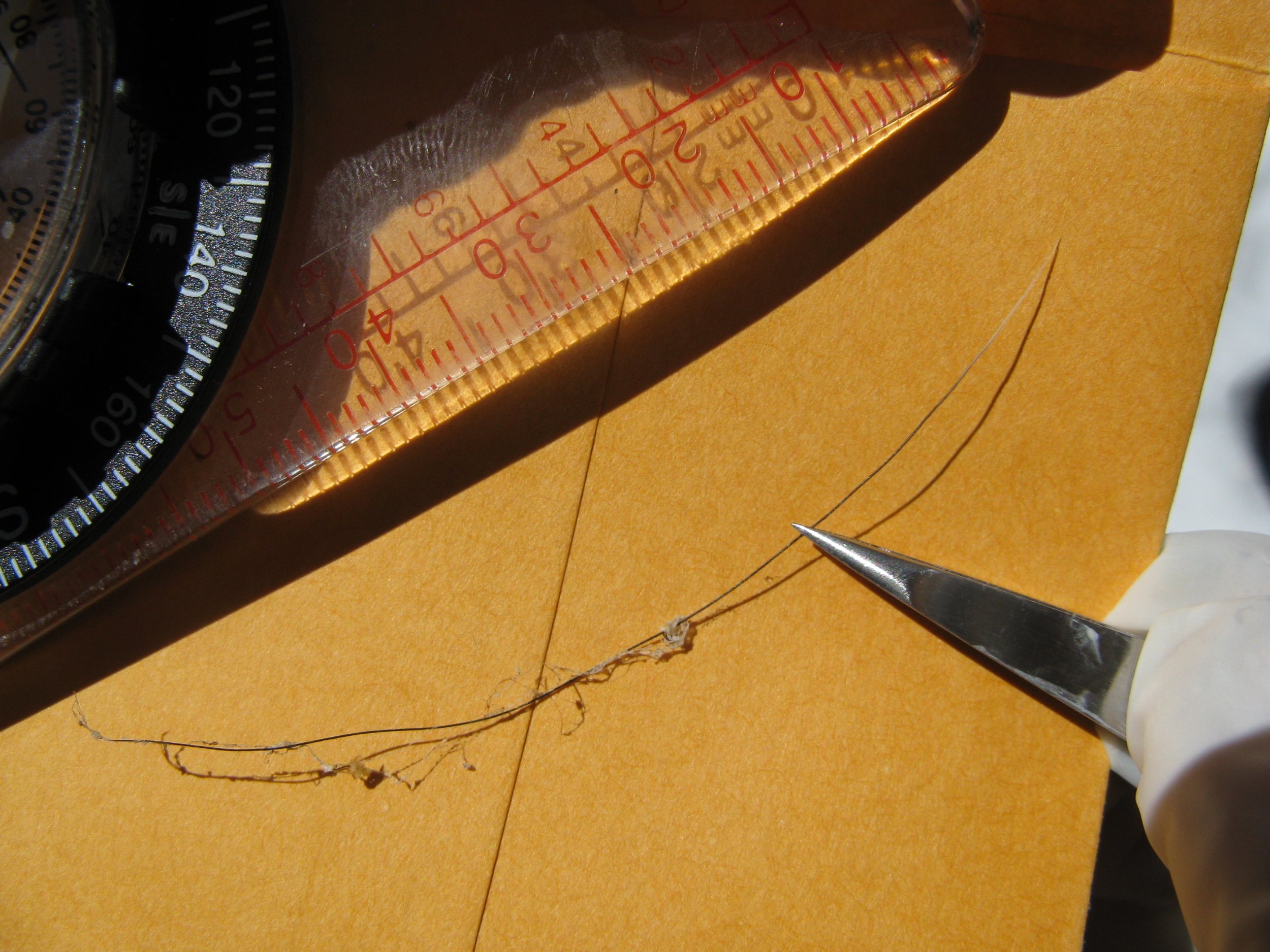
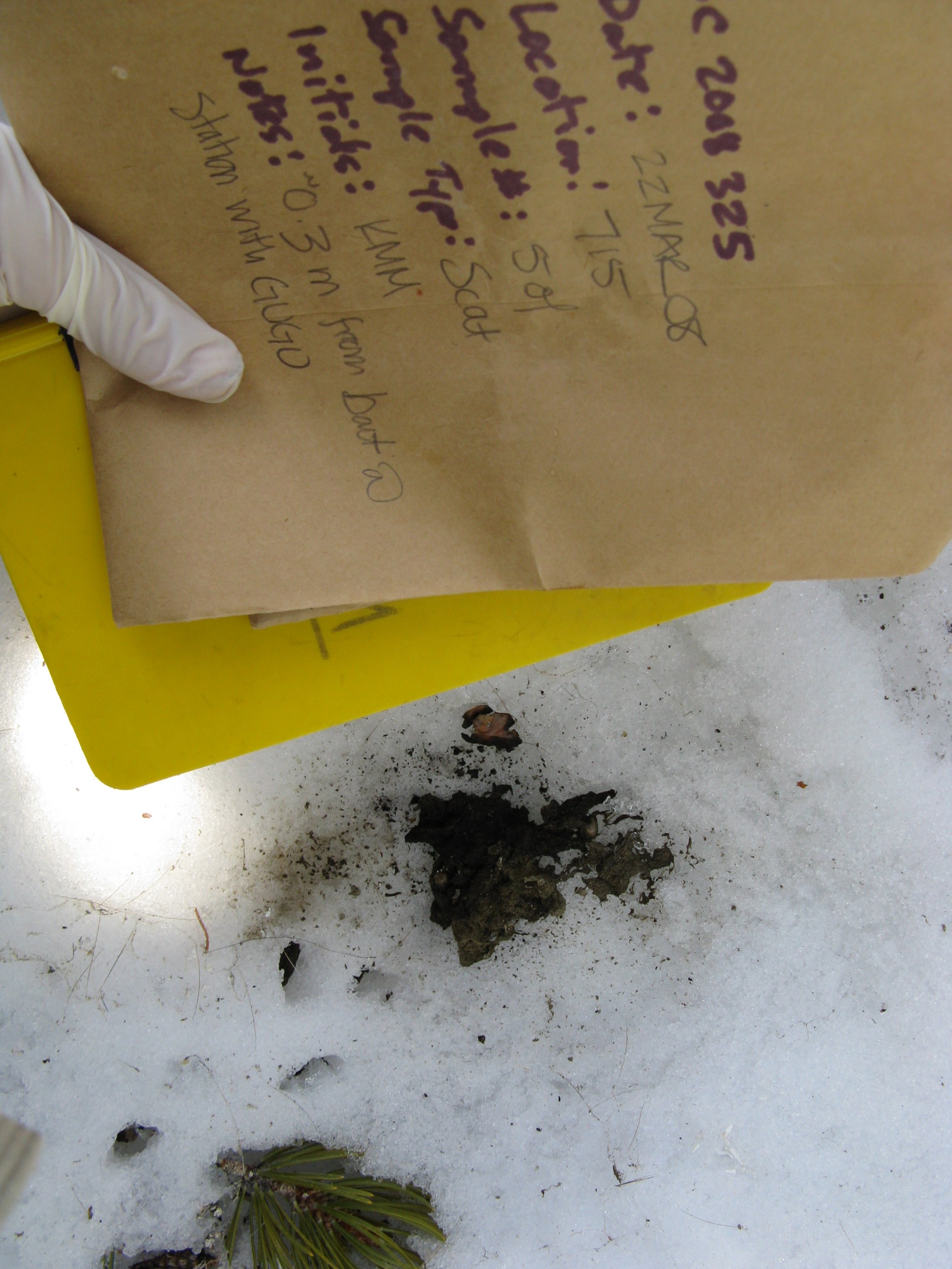
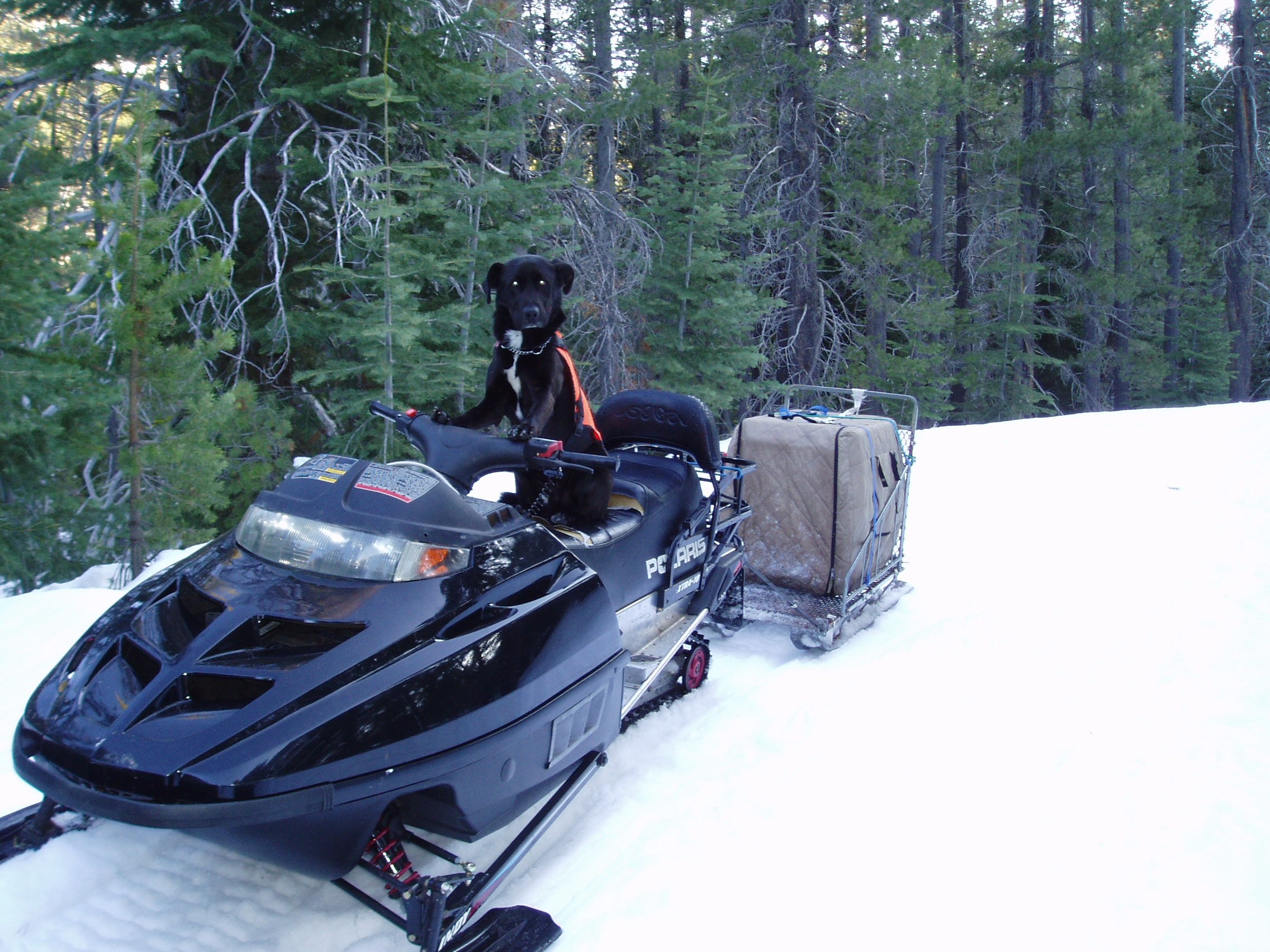



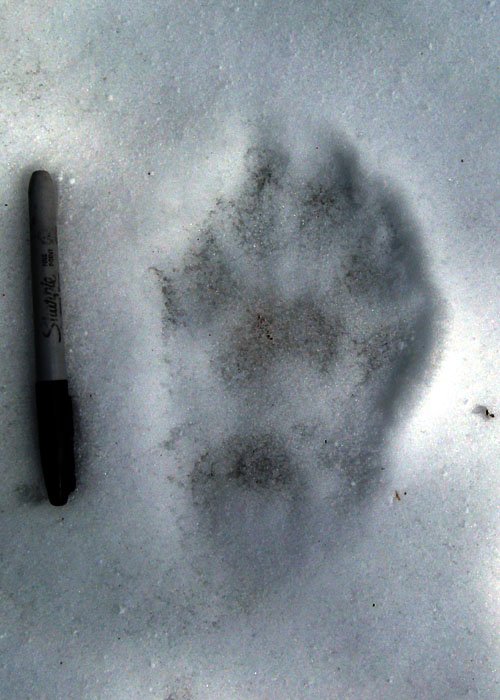
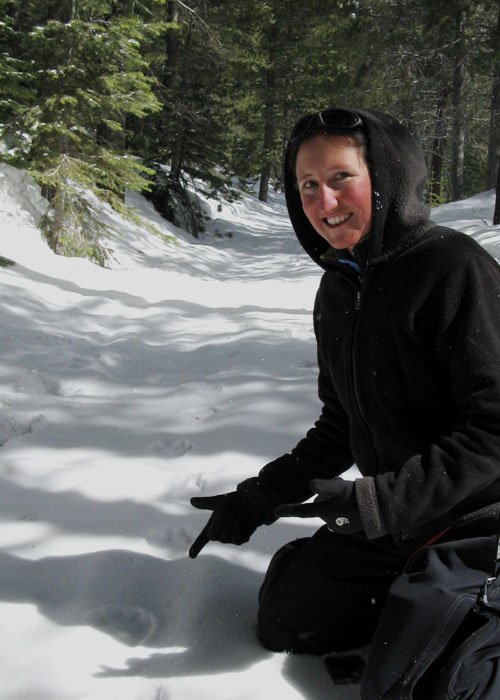

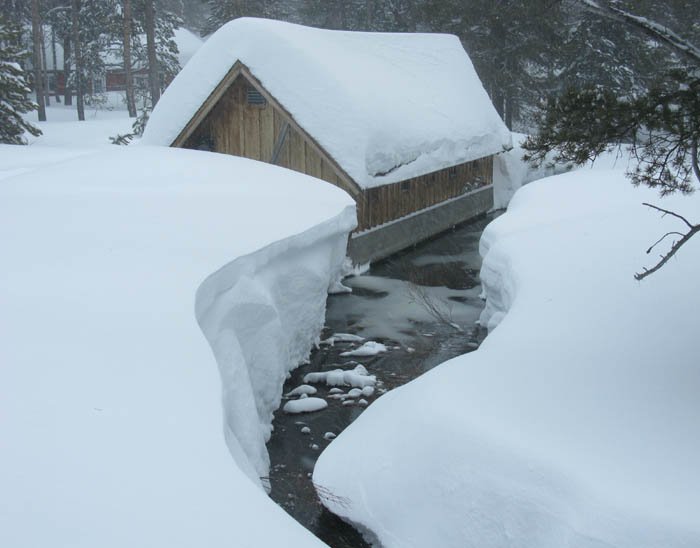
So, I run back, check the photo. It's still there. I try to email it to him. Wi‑Fi is really bad. A dozen times, I run back and forth trying to make calls. He actually picks up the phone around 9:00 AM when he’d normally show up to work.
I discuss what's happening and he leaves me with two things. One, don't tell anyone. Two, you need genetic evidence.
And I get it. I get it. I'm a wildlife biologist. We rely on our credibility. If I start saying we see Bigfoot running around the woods, no one's ever going to take me seriously again. And, two, California wolverines are super special. They're most closely related to those in Mongolia and Eurasia, so this would be a unicorn if it was a California wolverine.
Katie Moriarty shares her story at at Jewelbox Theater at the Rendezvous in Seattle in November 2022. Photo by Elizar Mercado.
So I think, “Okay, what am I going to do? I need to do something.” I take a breath and I go get a bigger jacket and I call everyone I know from northern Washington to southern California. I don't tell them what's going on but I urgently tell them what to bring and to come to me as fast as they can. Objectively, I can't even find a little marten. There's no way I can do this by myself.
And my last call is to my mom, my most reliable resource. To her, I have a shopping list, because that's what you do, Mom. Like, “Can you pick up enough barbed wire to fence several farms? Can you grab a lot of four‑by‑fours? Can you bring our chainsaw? Can you bring drills? Can you hurry?”
I also asked her to get my brother on the line. He's an excellent chef. He's cooked everywhere in the world. He said he'd come too.
So, within 48 hours, the station is alive. We've got French toast at 6:00 AM, we've got biking music for some reason at night. I have no idea why. And I am in Central Command, giving people tasks to go to the farthest away places. In less than a week, we have a hundred stations out. Detection dog teams have searched 60 linear miles and we have all searched the area the size of San Francisco. All the while, we're trying to get a lot of genetic evidence, which means shit.
We're picking up every shit we can find in the woods and we're putting them in paper bags. And before I could send them to the genetics lab, I need to dry them. the only way I could think of drying them is to put them in a garland above my heater.
So, here I am. I've got a hundred scats drying not 10 feet from my bed. I'm starting to hate the mystical wolverine.
A week goes by. Everyone goes home and I'm also hitting depression yet again with my little mini violin of sympathy and sorrow. I walk outside and I see something that you would never guess, which are wolverine tracks. They came to my stinky‑ass window.
The wolverine had walked down the road past my door sometime in the night. I got to follow that wolverine. My face was a smile cracked to the brim. I took so many digital pictures. I feel like a really proud mom. Like, “Here's a footprint. Here's a footprint with a Sharpie. Here's a footprint in the sun. Here's a footprint in the shade. Here's a footprint walking.”
Katie Moriarty shares her story at at Jewelbox Theater at the Rendezvous in Seattle in November 2022. Photo by Elizar Mercado.
Then I realized almost when it's going to get dark that wolverines might have white hair and I am looking at snow. So I crawl all the way back and I did not find anything.
Another week goes by and I get to a camera. And at this camera there's barbed wire. There's three pictures of a wolverine. There are four hairs and two flakes of scat smaller than a dime. That's the only evidence we got from that entire endeavor.
From that, we learned that that wolverine was a male and it walked from Idaho in the Sawtooth mountain range.
Wolverines can travel really far. In 2009, a year later, a wolverine named M56 moved from Montana to Colorado and, in 2016, was shot in North Dakota.
During my entire project, I found martens at ten stations, wolverine at three. And what I learned was if you have a dynamic group of individuals that could come and support you, who could come and try to find things that are impossible, you could achieve a great deal.
So when a friend calls you and asks you for something real crazy, show up. You never know what you could accomplish.
Thank you.
Part 2
Interviewer: Now, we're back with Katie to talk more about the science in her story.
Katie, thanks so much for joining us to. Start us off, tell us a bit more about how you got into the rare species game. You point out what a tough job it is. Why were you drawn to this line of work?
Katie: Yeah, I was a technician with the forest service. And for that entity, we worked on a lot of species and a lot of different projects. But the thing that really brought me in was the three combination of having a huge challenge with endless curiosity and the need to really integrate a lot of creativity.
I talked a little bit about how the challenge was really difficult and you have a lot of emotional and also physical endurance that you have to engage with. We learn more every year about rare and endangered species, so there's a lot of curiosity of how we could really integrate some of the science into our knowledge about their ecology.
Then it's just so interesting how many common tools are used to do science in this field, from things like gun brushes to get hair from animals to those signs that you would put out in front of your yard for political posters. We could change those into a survey device.
Interviewer: That's really cool. And I guess it doesn't hurt that a lot of times you find yourself encountering some pretty cute animals in your work. You've talked a little bit about your obsession with martens. Why are they such a favorite for you? Did you ever find any on the expedition that you talk about, your story?
Katie: Yeah. Martens are of course this big ‘capital P’ personality. These animals are about the size of a kitten and they are outrageous. They're shy and bold and aggressive and very cautious individuals.
During this particular study, we did find martens at some of our devices. I think ten by the final end of the winter survey. So, we got to see them and they're very exciting.
Interviewer: Is there anything that a marten can do that another weasel‑ish animal cannot that is really exciting?
Katie: Yeah. Martens have a lot of unique traits. I think I'm rather fond of the fact that they are highly arboreal. They could turn both their radius ulna and their tibia/fibula, so their bones in their legs 180 degrees. Which means they can move up and down and sideways on trees more agiley than a squirrel. They can go any direction. So it's like this three‑dimensional landscape that a marten can climb.
Interviewer: That's so cool. I'm so jealous. But, of course, the big cameo in your story is not a marten but a wolverine. I was so struck to hear that a big part of the stakes in your story is that wolverines have gotten so rare in the part of the country you were looking. What happened to wolverine populations and what's being done about that?
Katie: There's a few things. Of course, in California at this point, there might just be one wolverine, if not zero. And I think the reason why they are so rare is back historically, one, we trap them for fur pretty extensively. And, two, they were poisoned extensively. So, when people were trying to get rid of wolves in the day, they would drop aerially strychnine poison baits. And because wolverines, martens, fishers all eat carrion or dead animal, essentially, they would find those giant airdrop strychnine baits and consume them rapidly.
Interviewer: Wow! I mean, did it work on the wolves or was it just collateral damage all around?
Katie: Well, there also were not wolves in California until a few years ago, so we did a great job in the west eradicating a lot of species, and that was for different reasons.
But, currently, let's see. They are in low numbers throughout their range, so really low population sizes. Very small densities. If you think about wolverines, their home ranges are 100 to 600 miles. To put that in perspective, on your low end, the size of Sacramento, Las Vegas, Seattle, that'll fit one wolverine. And then if you think about bigger cities, even like Houston or Los Angeles that have two to three million people, still probably just one male wolverine.
Interviewer: That’s a lot of real estate.
Katie: It is. They need an extensive amount of space. And normally, in these rugged, remote snow‑covered areas. There's not a lot of available habitat, essentially, for them.
Females will den in snow dens. So they make these giant snow caves. One of the predictive models show that wolverine persistence in North America is related to snow cover and seasonal snow cover. That's really a challenge in the future.
Interviewer: Is there anything that humans can be doing now from, I guess, scientists to people who are professionally doing science but still want to help? Is there anything we can do to bring those wolverine populations back up?
Katie: Yeah. There's a few things. Certainly, there's a regulatory listing. If we do think that those populations need additional help, a lot of research can help. And then the typical person could be aware of the suite of carnivore species or species in these high remote areas and when they're out backcountry skiing or snowmobiling or in areas that are similar to where wolverines would live, just really pay attention to tracks and animals themselves.
Interviewer: Right. Though I don't know how a wolverine might feel about being found out in the wild. Do you think they ever enjoy the company of other animals?
Katie: There are some instances that these solitary animals that are essentially loners do actually have friends. And, rarely, you can see two males together or a male and a female together or a male raising the kid. There's new information that wolverines might be slightly more social than we ever anticipated.
Interviewer: Yeah. It's got to get lonely wandering around a patch of land the size of Houston.
Katie: I know. It's hard because unlike most of your lazy cats and dogs, your canids and your felids, these animals are moving around every day to like a really high input. For any of these, they're eating 25% of their body weight every day. And if you have eaten 100 hamburgers today and if you didn't eat 100 hamburgers, you would be really, really hangry. That's the type of style they have. They're roaming, trying to find food at any given moment.
Interviewer: I connect with that deeply.
Katie: Perfect.
Interviewer: All right. Well, any other fun wolverine facts to share?
Katie: Yeah. One of the really interesting things about some of these weasels but wolverines in general is they have delayed implantation. What that means is that they mate from like May to like mid‑August. That's when they're going to breed. But the embryo doesn't implant until March or April. So the females are not really pregnant but has the egg ready to go.
If she eats a ton of food and is really healthy, she'll implant and have one to two, maybe three kids. And if she doesn't have a lot of food, if there's a food shortage, she won't have any at all.
Interviewer: That sounds like amazing birth control, right?
Katie: Yeah, it's all about limitation. And another thing about both male and female wolverines and martens and others is they don't become sexually reproductive until they're two years old.
Interviewer: And that's late.
Katie: It is late. For martens, at least, the oldest one I've ever captured is seven. And most of the time, like three or four. If you think about these animals, if their age limit is five, six, they don't start having kids until they're two and they have one kid on average, occasionally two, it's not a lot of reproductive output.
Interviewer: Right. Well, they have to focus on their careers first.
Katie: As do we all, yeah.
Interviewer: Amazing. Martens and other Mustelids feminist icons.
But let's pivot back to wolverines one more time. They are obviously incredibly impressive in their own right. What is something else that makes them just really badass?
Katie: Wolverines are probably one of the most intimidating mammals. They only weigh about the size of a Cocker Spaniel, so 20 to 50 pounds. But they'll take on a grizzly bear. They'll take on a pack of wolves. They'll take on a caribou by themselves to try to eat it and kill it. So they're very iconic with Wolverine, the X‑Men character. Very extremely bold, capable species.
Interviewer: So the X‑Men Wolverine is a big fan of his claws, but is that actually how wolverines fight or are they more bitey?
Katie: They would be both. A wolverine would use both their claws and their really powerful muscles as well as their jaws. They can, with their jaws, break through bone. More than any other animal, they've got a really strong connection between their upper and lower jaw and also a really strong muscle to be able to control that. Nothing could get past a wolverine jaw, really.
Interviewer: That's great. What does animal scat smell like when it's being dried over a heater?
Katie: Oh, it's horrible. It is all the pungent nature of an aging trash can in a dog park, because these animals are eating small mammals and rabbits and what have you. So it is really rancid and gross. I can't describe more how awful it could be.
We do have dehydrators now. I mean, I have upped my game. So we have lots of food dehydrators that I keep in, say, bathrooms or sheds. I no longer dry scats in my room.
Interviewer: I imagine your family thanks you for that.
Katie: Yeah.
Interviewer: Really glad that that is something that's advanced since your story.
Katie: Yeah. We innovate here.
Interviewer: All right. I think that is all the time we have. Thank you so much for joining us. We are so grateful to you for sharing your story.
Katie: You're welcome. Thank you for the time.


